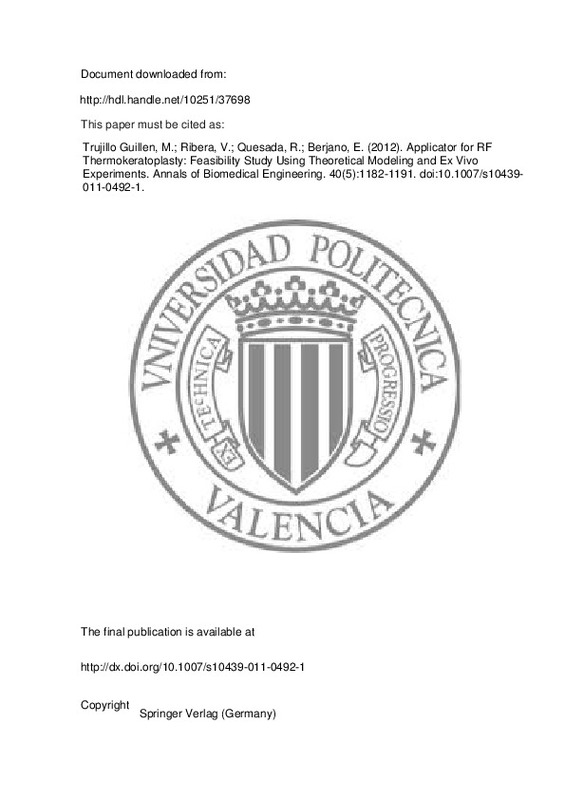Abraham, J. P., and E. M. Sparrow. A thermal-ablation bioheat model including liquid-to-vapor phase change, pressure- and necrosis-dependent perfusion, and moisture-dependent properties. Int. J. Heat Mass Transf. 50:2537–2544, 2007.
Alió, J. L., M. I. Ramzy, A. Galal, and P. J. Claramonte. Conductive keratoplasty for the correction of residual hyperopia after LASIK. J. Refract. Surg. 21:698–704, 2005.
Arata, M. A., H. L. Nisenbaum, T. W. Clark, and M. C. Soulen. Percutaneous radiofrequency ablation of liver tumors with the LeVeen probe: Is roll-off predictive of response? J. Vasc. Interv. Radiol. 12:455–458, 2001.
[+]
Abraham, J. P., and E. M. Sparrow. A thermal-ablation bioheat model including liquid-to-vapor phase change, pressure- and necrosis-dependent perfusion, and moisture-dependent properties. Int. J. Heat Mass Transf. 50:2537–2544, 2007.
Alió, J. L., M. I. Ramzy, A. Galal, and P. J. Claramonte. Conductive keratoplasty for the correction of residual hyperopia after LASIK. J. Refract. Surg. 21:698–704, 2005.
Arata, M. A., H. L. Nisenbaum, T. W. Clark, and M. C. Soulen. Percutaneous radiofrequency ablation of liver tumors with the LeVeen probe: Is roll-off predictive of response? J. Vasc. Interv. Radiol. 12:455–458, 2001.
Berjano, E. J. Theoretical modeling for radiofrequency ablation: state of-the-art and challenges for the future. Biomed. Eng. Online 5:24, 2006.
Berjano, E. J., J. L. Alió, and J. Saiz. Modeling for radio-frequency conductive keratoplasty: implications for the maximum temperature reached in the cornea. Physiol. Meas. 26:157–172, 2005.
Berjano, E. J., F. Burdío, A. C. Navarro, J. M. Burdío, A. Güemes, O. Aldana, P. Ros, R. Sousa, R. Lozano, E. Tejero, and M. A. de Gregorio. Improved perfusion system for bipolar radiofrequency ablation of liver. Physiol. Meas. 27:N55–N66, 2006.
Berjano, E. J., E. Navarro, V. Ribera, J. Gorris, and J. L. Alió. Radiofrequency heating of the cornea: an engineering review of electrodes and applicators. Open Biomed. Eng. J. 1:71–76, 2007.
Berjano, E. J., J. Saiz, J. L. Alió, and J. M. Ferrero. Ring electrode for radio-frequency heating of the cornea: modelling and in vitro experiments. Med. Biol. Eng. Comput. 41:630–639, 2003.
Berjano, E. J., J. Saiz, and J. M. Ferrero. Radio-frequency heating of the cornea: theoretical model and in vitro experiments. IEEE Trans. Biomed. Eng. 49:196–205, 2002.
Bischof, J. C., and X. He. Thermal stability of proteins. Ann. N. Y. Acad. Sci. 1066:12–33, 2005.
Doss, J. D., and J. I. Albillar. A technique for the selective heating of corneal stroma. Contact Intraocular Lens Med. 6:13–17, 1980.
Ehrlich, J. S., and E. E. Manche. Regression of effect over long-term follow-up of conductive keratoplasty to correct mild to moderate hyperopia. J. Cataract Refract. Surg. 35:1591–1596, 2009.
Gruenberg, P., W. Manning, D. Miller, and W. Olson. Increase in rabbit corneal curvature by heated ring application. Ann. Ophthalmol. 13:67–70, 1981.
Haines, D. E., D. D. Watson, and A. F. Verow. Electrode radius predicts lesion radius during radiofrequency energy heating. Validation of a proposed thermodynamic model. Circ. Res. 67:124–129, 1990.
Henriques, F. C. Studies of thermal injury. Arch. Pathol. 5:489–502, 1947.
Jo, B., and A. Aksan. Prediction of the extent of thermal damage in the cornea during conductive keratoplasty. J. Therm. Biol. 35:167–174, 2010.
Kymionis, G. D., P. Titze, M. M. Markomanolakis, I. M. Aslanides, and I. G. Pallikaris. Corneal perforation after conductive keratoplasty with previous refractive surgery. J. Cataract Refract. Surg. 29:2452–2454, 2003.
Miller, D., and W. J. Manning. Alterations in curvature of bovine cornea using heated rings. Invest. Ophthalmol. 297, 1978.
Miller, M. W., and M. C. Ziskin. Biological consequences of hyperthermia. Ultrasound Med. Biol. 15:702–722, 1989.
Moshirfar, M., M. Feilmeier, and R. Kumar. Anterior chamber inflammation induced by conductive keratoplasty. J. Cataract Refract. Surg. 31:1676–1677, 2005.
Ou, J. I., and E. E. Manche. Corneal perforation after conductive keratoplasty in a patient with previously undiagnosed Sjögren syndrome. Arch. Ophthalmol. 125:1131–1132, 2007.
Pallikaris, I. G., T. L. Naoumidi, and N. I. Astyrakakis. Long-term results of conductive keratoplasty for low to moderate hyperopia. J. Cataract Refract. Surg. 31:1520–1529, 2005.
Pearce, J., D. Panescu, and S. S. Thomsen. Simulation of diopter changes in radio frequency conductive keratoplasty in the cornea. WIT Trans. Biomed. Health 8:469–477, 2005.
Stahl, J. E. Conductive keratoplasty for presbyopia: 3-year results. J. Refract. Surg. 23:905–910, 2007.
Thomsen, S., J. A. Pearce, and W. F. Cheong. Changes in birefringence as markers of thermal damage in tissues. IEEE Trans. Biomed. Eng. 36:1174–1179, 1989.
Trembly, B. S., N. Hashizume, K. L. Moodie, K. L. Cohen, N. K. Tripoli, and P. J. Hoopes. Microwave thermal keratoplasty for myopia: keratoscopic evaluation in porcine eyes. J. Refract. Surg. 17:682–688, 2001.
Xu, W., P. Ye, K. Yao, J. Ma, and H. Xu. Conductive keratoplasty for the treatment of astigmatism induced by corneal trauma or incision. J. Refract. Surg. 26:33–42, 2010.
[-]







![[Cerrado]](/themes/UPV/images/candado.png)


